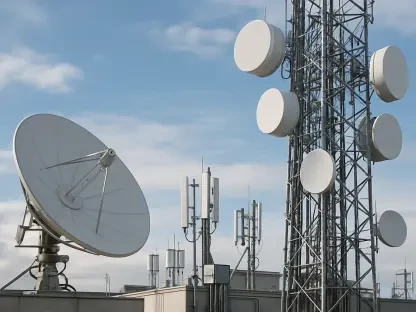In today’s hyper-connected world, the demand for ubiquitous and dependable communication has never been higher, propelling Non-Terrestrial Networks (NTNs) to the forefront of telecommunication advancements. Entwined with both cellular and satellite technologies, NTNs are transforming the way connectivity is achieved beyond traditional limitations. This innovative integration with 5G networks aims to overcome geographical hurdles, providing reliable connectivity where terrestrial networks falter. The pivotal role of NTNs in modern communication infrastructure is becoming increasingly evident, especially in offering essential services in remote and underserved regions. As stakeholders recognize the strategic significance of NTNs, numerous challenges and opportunities unfold in the landscape of global connectivity, promising a revolution in how people, devices, and industries communicate.
Pioneering Technological Integration
Non-Terrestrial Networks harness the capabilities of satellites to offer high-speed connectivity, integrating seamlessly with existing terrestrial telecom infrastructures. The year 2025 has seen considerable progress in the launch of satellites equipped with NTN capabilities. These technological strides highlight the urgency for innovative solutions that bridge digital divides. Satellites today are not merely to provide sporadic service in designated pockets but to establish a continuous and expansive web of communication support. Technological advancements are crucial, not just to launch stronger satellites, but to ensure they work harmoniously with existing 5G infrastructure. This symbiotic relationship promises to enhance reliability and bandwidth, dovetailing with advanced networking protocols to offer unmatched connectivity solutions.
The transition to NTNs involves careful orchestration, aiming at uniform standards that can operate seamlessly globally. With rapid technological advancements, collaboration across industries is vital for developing reliable and efficient satellite communication systems. The convergence between terrestrial and space-based networks is not just a technical endeavor; it represents a shift towards more inclusive and comprehensive network architectures, fundamentally changing how data and information circulate worldwide. With a robust set of standards driving adoption, this technological integration is crucial for expanding the reach of NTNs and fulfilling their potential to universally connect disparate and isolated regions.
Addressing Market Opportunities and Challenges
A burgeoning demand for comprehensive and resilient communication networks has directed attention to the immense potential of NTNs. Initial explorations have focused on specific use cases like narrowband IoT applications in industries and emergency SMS services for consumers, offering foundational steps that pave the way for more extensive solutions including voice and data services. The promise of NTNs extends beyond current capabilities, encompassing market segments such as industrial IoT, offering scalable solutions for connectivity challenges across various sectors. Significant interest is drawn from sectors seeking reduced barriers in deploying IoT solutions in areas previously considered uneconomical due to connectivity constraints.
Despite promising prospects, deploying NTNs presents substantial challenges. Technical complexities arising from satellite movements demand rigorous testing and innovative solutions to ensure consistent service quality. Doppler shifts, transmission delays, and signal attenuation are inherent issues requiring sophisticated technological interventions. Developing interoperable systems that bridge historically siloed telecom verticals is critical. The transitional period necessitates agile and innovative responses from technology providers to overcome these challenges and capitalize on the potential NTNs offer. As the market explores these network propositions, unique opportunities for expanding communication capabilities and increasing network resilience emerge, warranting further exploration and investment.
Strategic Collaborations and Industry Advancements
The progress and success of NTNs hinge significantly on strategic collaborations within the telecommunications industry. Partnerships between Mobile Network Operators (MNOs) and satellite providers are key to driving advancements and facilitating the broader adoption of NTN services. Companies like Viasat and Verizon are at the forefront of these developments, working on several fronts to push NTN offerings from direct-to-consumer services to sophisticated IoT applications. By fostering cross-industry partnerships, these companies are poised to address existing technological gaps while anticipating future demands for satellite-fueled communication solutions.
Collaborative endeavors not only facilitate the integration of NTNs into mainstream telecommunication but also promote innovation in service delivery and product accessibility. A pivotal element of this collaboration is the development of companion devices, which aim to extend satellite service access without necessitating major hardware overhauls for consumers. These initiatives highlight a concerted effort to make NTNs economically viable and technically compatible with existing devices, broadening the accessibility footprint of satellite-based services. The interplay of strategic alliances and technological innovation is crucial in crafting a sustainable and expansive NTN ecosystem, setting the stage for future advancements in global communications.
Prospects and Future Pathways
As the market embraces NTNs, industry analysts forecast significant growth and evolving trends within this sector, projecting extensive advancements in satellite service revenues by the latter part of the decade. Research firms such as ABI Research and Lucintel offer insights into burgeoning investments aimed at enhancing NTN infrastructure and capabilities. The anticipated increase in demand for high-speed and resilient connectivity solutions reflects broader trends toward more integrative and flexible telecom systems, positioning NTNs as pivotal components in the future telecommunications landscape.
The path forward for NTNs is laden with both opportunities and challenges. Industry stakeholders must navigate technological, regulatory, and economic landscapes to achieve sustainable growth and integration. Collaborative ecosystems and standardized frameworks hold the key to unlocking the full potential of NTNs, as diverse use cases continue to evolve and mature. The coming years promise not only technological advancement but also a more equitable and interconnected world, where barriers to communication are systematically dismantled through concerted industry efforts and innovations.
Conclusion: Unveiling Future Possibilities
Non-Terrestrial Networks (NTNs) employ satellite technology to deliver fast connectivity, seamlessly integrating with current terrestrial telecom infrastructure. In 2025, there have been significant strides in launching satellites with NTN capabilities, underscoring the need for innovative solutions to bridge digital gaps. Today’s satellites aim not just to offer service sporadically in select areas but to create a comprehensive and continuous network of communication support. Advances in technology are critical not only for launching more powerful satellites but also for ensuring their compatibility with existing 5G infrastructures. This partnership enhances reliability and bandwidth, aligning with advanced networking protocols to provide unmatched connectivity.
Adapting to NTNs demands careful coordination, aspiring to establish uniform standards that function seamlessly worldwide. With swift technological growth, collaboration between industries is essential to develop reliable satellite communication systems. Merging terrestrial and space-based networks reflects a transition to more inclusive network architectures, revolutionizing global data exchange. With strong standards promoting adoption, this integration is vital for extending NTNs’ reach, realizing their potential to connect isolated regions across the globe and creating a more universally connected world.









